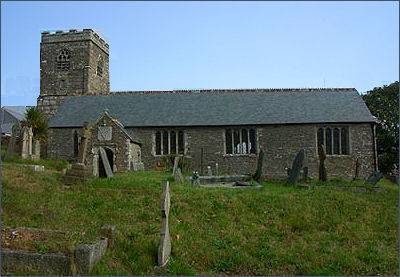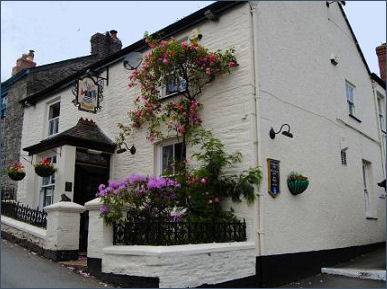Golant
OS Grid ref:- SX 122 548
 Golant lies on the west bank of the River Fowey and is situated around two miles (3 km) to north of Fowey and seven miles (11 km) east of St Austell. The small Cornuish waterside village is on the Saints' Way long-distance footpath which runs from Padstow on the north coast to Fowey.
Golant lies on the west bank of the River Fowey and is situated around two miles (3 km) to north of Fowey and seven miles (11 km) east of St Austell. The small Cornuish waterside village is on the Saints' Way long-distance footpath which runs from Padstow on the north coast to Fowey.
The village church, situated at the top of Golant, is dedicated to St Sampson of Dol and dates back to the thirteenth century. Saint Sampson was the son of Amon of Demetia and Anna of Gwent, daughter of Meurig ap Tewdrig, King of Glamorgan and Gwent. He is colourfully portrayed in some of the churches stained glass windows and sometimes stayed at Golant while travelling to Brittany. St Sampson became the archbishop of Dol. A holy well stands near the porch in the churchyard, enclosed in a fifteenth century wellhouse.
During the English Civil War a large parliamentary army fought Royalist forces in area in 1644. King Charles I was present during the campaign and camped at Castle Dore on the night before the surrender of the Parliamentary army. The Earl of Essex and other prominent parliamentarians escaped by boat to Plymouth, many seventeenth century cannonballs and musket balls have been discovered in the area.
 Central to the village is the Fisherman’s Arms where visitors can relax with drinks, snacks and meals and enjoy the view. The charming character Inn dates back to 1826 and has spacious outside terraces boasting superb views over the River Fowey. The Cormorant Hotel offers the luxury option with views of the River Fowey from every room.
Central to the village is the Fisherman’s Arms where visitors can relax with drinks, snacks and meals and enjoy the view. The charming character Inn dates back to 1826 and has spacious outside terraces boasting superb views over the River Fowey. The Cormorant Hotel offers the luxury option with views of the River Fowey from every room.
At the South end of the village green is the Human Sundial, designed crafted and built by villagers out of local slate in celebration of the millen
The Sawmills recording studio was established at Golant in 1974. The main building is a seventeenth century water mill and the site has a documented history stretching back to the eleventh century. Famous recording artists include XTC, Robert Plant, The Stone Roses, Oasis, The Verve, Supergrass, Muse, and Razorlight have recorded at the Sawmills.
The surrounding area is a haven for wildlife, particularly estuary birds including heron, egrets, cormorants, kingfishers, Canadian geese, redshanks, curlews and many seasonal visitors including ospreys which stop off in Penpoll Creek on their annual migration. Deer are also sighted in the surrounding woodland.
An interesting Iron Age Fort, Castle Dore, dating from between between the 1st centuries BC and the 5th Century AD, lies nearby. The earthwork, which measures 225 feet in diameter, has twin defences, each consists of a bank about 8 feet high with a deep outer ditch. Excavations have revealed a stone guard house by the inner entrance. The hall was believed to have been the fortress of King Mark of Cornwall.
The author Kenneth Graham wrote "Tales of the Riverbank" inspired by a boating trip from Fowey to Golant. "The Wind in the Willows" was published in June 1908 and it is believed that this stretch of the River Fowey was the inspiration for the book.